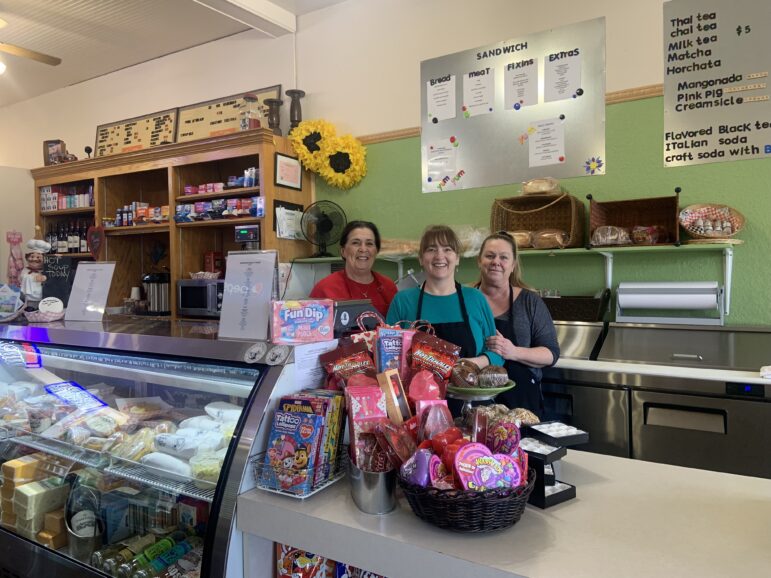POINT ARENA, CA, 2/15/23 — Christie, who works behind the counter at Center Street Market along Point Arena’s main drag, laughed a little as she recalled when no less than 55 trees fell on her property during the early January bomb cyclone. One fell on her generator shed; another fell on her roof.
“A lot of them snapped in half,” she said. “I was amazed.” Her family worked their way across the property to clear the debris, cutting the massive trees to open up access. Now, they need to make repairs to their home.
The Federal Emergency Management Agency (FEMA) visited Christie this week to take a look at the damage and register her to apply for assistance. Mendocino County qualified last week for individual aid to residents following FEMA assessments after the atmospheric river storms in late December and early January. But as a representative for California Office of Emergency Services (Cal OES) told The Mendocino Voice on Tuesday, at FEMA’s newly established disaster recovery center at Point Arena’s city hall, sometimes it’s hard to say exactly how much a given population suffered until people begin applying for assistance.
Mendocino County residents can register with FEMA online, by phone, or in person at a disaster recovery center before the deadline of March 16. FEMA representative Patrick Boland said Tuesday morning that the agency had registered some 70 people in Mendocino County in these early days of funding availability, with requests for about $45,000 in housing assistance. The majority of those applications came from Point Arena, with some from Willits, but anyone in the county who suffered storm impacts can apply.
“People sometimes hesitate,” he said, explaining one common reason: that insurance claims can take a long time to process. But applicants can provide FEMA with additional documentation, like an accepted or rejected claim, after submitting their request for aid. He emphasized, “Don’t wait to apply.”
The Point Arena disaster recovery center will remain in place through Friday, Feb. 17, at which point it will transition back to a Mobile Recovery and Intake Center (MRIC), with only FEMA officials on site to register people for aid as opposed to the more varied resources of a disaster recovery center. Currently, that MRIC site is slated to remain open until Feb. 24. A MRIC is open in the parking lot of Willits’ library until Saturday, when a full recovery center will open at the Willits Community Center and serve Mendocino County there through Feb. 24.
As Boland explained, FEMA doesn’t only stay put, though — a key part of their work involves traveling the community to reach residents in need. At least two of these disaster survivor assistance teams are currently deployed in Mendocino County.
“They go out and walk the neighborhood, and knock on doors and try to meet people,” he said. The agency would love to hear from locals who “know of someone that might not have been reached.”
The full-on Disaster Recovery Center provides aid options not only from FEMA, but resources from local groups — as well as representatives on hand from a long list of state agencies. These agencies offer survivors an array of services, from advice on supplemental grants programs to assistance with obtaining lost vital records.
The Small Business Administration (SBA) is on-site as well, offering low-interest loans of up to $2 million for businesses which suffered economic injury or physical damage, including losing merchandise because of power outages; up to $200,000 for homeowners to make repairs; and up to $40,000 to replace belongings for homeowners and renters. The loans can be paid out over as many as 30 years, and you don’t necessarily have to accept the money once you qualify for it. Though the money has to be repaid, SBA representative Cynthia Cowell explained that it’s a good option in a bind.
“I know nobody wants a loan right now, but you’ll come closer to recovering fully if you take an SBA loan,” she said in a phone conversation. There’s also a long grace period, she added: “Your first payment wouldn’t be due until a year after your first disbursement.” The loans don’t accrue interest during the first 12 months.
One impacted business was Center Street Market, which will celebrate its first year in operation on Thursday. The market lost power for days — along with all of Point Arena’s downtown — when the storms first rolled in. Owner Zephyr said she kept their merchandise cold with gallons of ice, and then used a backup generator to power up fridges and freezers for bursts of time until power was restored to the whole street by generator.

Point Arena’s geographic isolation can make it harder to cope in a storm, as flooded roads or routes blocked by downed trees limit the capacity to respond to issues like power outages or even to put gas in your car — part of the challenge is knowing what to expect.
“This kind of storm hasn’t happened for quite a while, but we’ve experienced the same kind of thing in the past,” said longtime resident Bill Rancine. Trees fell at his home, too, and he and his wife “hunkered down” while power was out.
Next door, Coast Community Library stayed open every day til dark despite being without power. The library powered up a charging station at a business that had a generator, and then provided residents with the chance to charge their devices.
“I think that the fact that PG&E was able to get one of the large generators up and running for Main Street so quickly was really helpful, because then people had a place to go,” Librarian Melissa Hannum told The Voice.
The library is part of the Point Arena Fire Safe Council, which focuses on emergency preparation broadly and has a table at the disaster recovery center. In considering the city’s response, the Council and Hannum hope to strategize on how to keep people better-informed.
“We are so dependent upon devices now,” Hannum explained. She felt that during the storms, residents didn’t know about all the resources available — such as the library — but was also grateful that local grocery stores in Point Arena and Gualala were able to stay open and help residents.
Hannum also speculated that COVID-19 made this particular storm a bit more difficult.
“The fact that people are still getting sick keeps people out of help mode,” she said.
For those who could still use help, more details about local disaster recovery centers and how to apply for FEMA aid can be found here.
Note: Kate Fishman covers the environment & natural resources for The Mendocino Voice in partnership with a Report For America. Her position is funded by the Community Foundation of Mendocino, Report for America, & our readers. You can support Fishman’s work with a tax-deductible donation here or by emailing [email protected]. Contact her at KFishman@mendovoice.com or at (707) 234-7735. The Voice maintains editorial control and independence.





